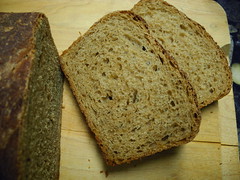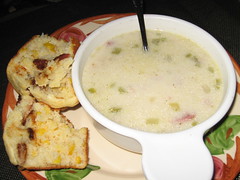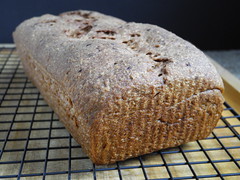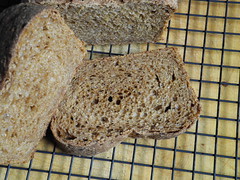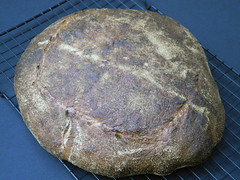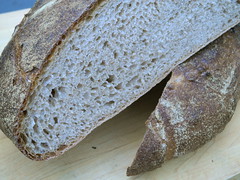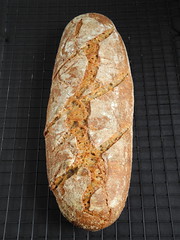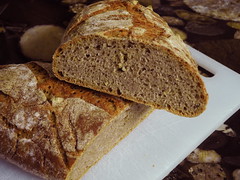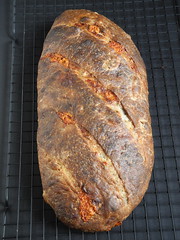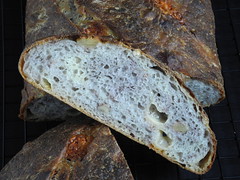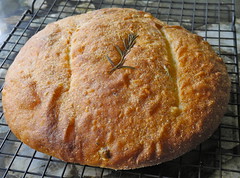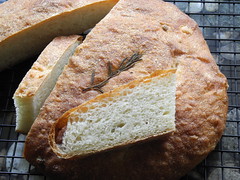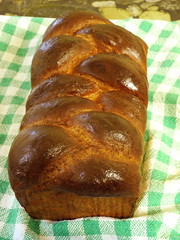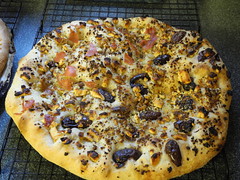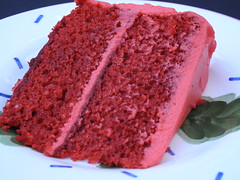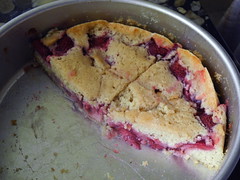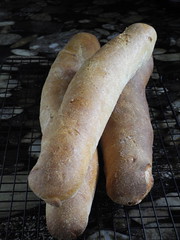 I mostly worked half days this pre-holiday week, using up some of my excess annual leave. This let me tackle the relatively quick stollen during the week instead of waiting for a weekend opportunity. My stollen, like my panettone, has no candied fruit, though I did use some candied orange and lemon peel. (First time I'd ever tried the candied peels, and I won't repeat the experiment--they really are bitter despite being candied, and many times have an unpleasant texture.) My fruit mix was dried tart cherries, chopped dried apricots, and golden raisins. I decided not to add crystallized ginger, though maybe on some other occasion that would be interesting. All that plus another 1/2 cup of mixed fruit went into a plastic container with the brandy and orange extract 4 days before starting the bread. I shook the container regularly to re-distribute the liquid.
I mostly worked half days this pre-holiday week, using up some of my excess annual leave. This let me tackle the relatively quick stollen during the week instead of waiting for a weekend opportunity. My stollen, like my panettone, has no candied fruit, though I did use some candied orange and lemon peel. (First time I'd ever tried the candied peels, and I won't repeat the experiment--they really are bitter despite being candied, and many times have an unpleasant texture.) My fruit mix was dried tart cherries, chopped dried apricots, and golden raisins. I decided not to add crystallized ginger, though maybe on some other occasion that would be interesting. All that plus another 1/2 cup of mixed fruit went into a plastic container with the brandy and orange extract 4 days before starting the bread. I shook the container regularly to re-distribute the liquid.Not counting the fruit-soaking, stollen is a one-day bread. The process starts with a yeasty sponge with flour and whole milk, and that sits for an hour until very foamy. The main dough is more flour, a little sugar, cinnamon, salt, then the wet ingredients of butter, the sponge, and an egg. Or half an egg, in my case--I halved the recipe as usual. That dough is mixed, sits for 10 minutes, then the fruit is added. I added very little water to the dough process, maybe a half-ounce, but the fruit was very moist and tipped the balance the other way and I added more than a quarter cup more flour to get a dough that wasn't too sticky to handle. In the process (I machine-knead) the dough got worked enough for the fruits to color the dough.
 First rise was very slow--I can't see how I could have killed the yeast, so I attribute it to the heavy load of sweet fruit inhibiting the yeast activity. After 2 hours with only a little bit of puffy area showing, I gave up and formed the loaf. The instructions for folding the stollen were pretty baffling even with several photos to illustrate them, but I made some reasonable attempt at the double fold shown. As a lover of almond paste the option to include marzipan or almond paste instead of sliced almonds was the way to go, though that may have complicated my attempts to follow the shaping method--I was using the tube-form marzipan (Odense), that being what was on hand, so I cut the tube in half lengthwise, and rolled half out to the length of my dough. That got tucked into the first fold along with a little additional soaked fruit. For the second fold, I cut a strip off the remaining marzipan, again rolled it to flatten, and tucked it in. My loaf didn't have the fruit spilling out of the folds, but the thing was more or less shaped like the picture.
First rise was very slow--I can't see how I could have killed the yeast, so I attribute it to the heavy load of sweet fruit inhibiting the yeast activity. After 2 hours with only a little bit of puffy area showing, I gave up and formed the loaf. The instructions for folding the stollen were pretty baffling even with several photos to illustrate them, but I made some reasonable attempt at the double fold shown. As a lover of almond paste the option to include marzipan or almond paste instead of sliced almonds was the way to go, though that may have complicated my attempts to follow the shaping method--I was using the tube-form marzipan (Odense), that being what was on hand, so I cut the tube in half lengthwise, and rolled half out to the length of my dough. That got tucked into the first fold along with a little additional soaked fruit. For the second fold, I cut a strip off the remaining marzipan, again rolled it to flatten, and tucked it in. My loaf didn't have the fruit spilling out of the folds, but the thing was more or less shaped like the picture.The second rise was again slow--I gave it an hour and a half, and saw very little increase in size. Finally with the hour getting late, I went ahead and baked it, and the results seem OK to me. The loaf is a little dense with the various fruits, and the marzipan didn't give me the effect I wanted--the larger piece folded as I shaped the loaf and is a thick C-shaped piece in each slice. What I wanted was for the marzipan to meld a little with the bread so I wouldn't get a separate "marzipan bite" in each slice. Maybe almond paste would be softer and integrate better, maybe a superior type of marzipan would, or maybe this just isn't the nature of the beast. If I repeat the stollen, I think I'll go with sliced almonds. <g> Actually, I'll probably go back to the panettone--I liked it better than what I got with the stollen recipe.



